- Updated: November 9, 2022
Blade vs. Mallet Putter
The mallet putter gives players forgiveness, while the blade putter gives players feedback. Whichever information you value more should influence what you play.
Blade putters are the “original putter.” Blades look traditional and elegant, are aesthetic to onlookers, and to golf purists, are an integral and staple part of the art of putting.
The Mallet style putter is a relatively new putter head shape said to have a higher “moment of inertia” (M.O.I.) due to its increased head weight, often face-balanced design, and overall larger putter head mass.

A mallet putter head design centers around the idea that the majority of the putters overall weight is positioned further away from the putter face, reducing the adverse effects caused by off-center hits and increasing stability and balance of the putting stroke for some players.
Blade putters main advantage is actually how simple, cosmetically pleasing, and to some, confidence-inspiring they are to look at when standing over a putt.
Mallet putters have a lot more variation in head shapes but are usually round, square, a “half moon” shape, or essentially any shape that doesn’t resemble a straight “blade-like appearance” like blade putters of olden times.
Which one should you use?
According to Brad Faxon, one of the most prolific putters in professional golf history, “Five years ago (in reference to 2017), only 20% of the field at a typical P.G.A. Tour event would use a mallet. Last week (referring to the 2022 season), 72% of players were using a mallet.”
Brandel Chamblee, current professional Golf commentator, writer, formerly a good professional player in his own right, responds to Faxon by saying, “I almost liken the comparison between a blade and mallet putter to “perimeter weighted irons” versus “blade style irons.” The first gives players forgiveness, while the latter gives players feedback. Whichever information you value more should influence what you play.”
Because blade style putter heads are so much thinner and petite than the much larger club heads on mallet putters, their feedback to players’ hands is generally considered more significant than mallet putters.
This line of thought gives even more credence to the idea that “feel” based players will excel with a blade putter.
What is a Blade Putter?
First and foremost, blade putters do require more work out of the player than a mallet putter. Golfers will have to control the putter face more with a blade style putter than mallet style putters.
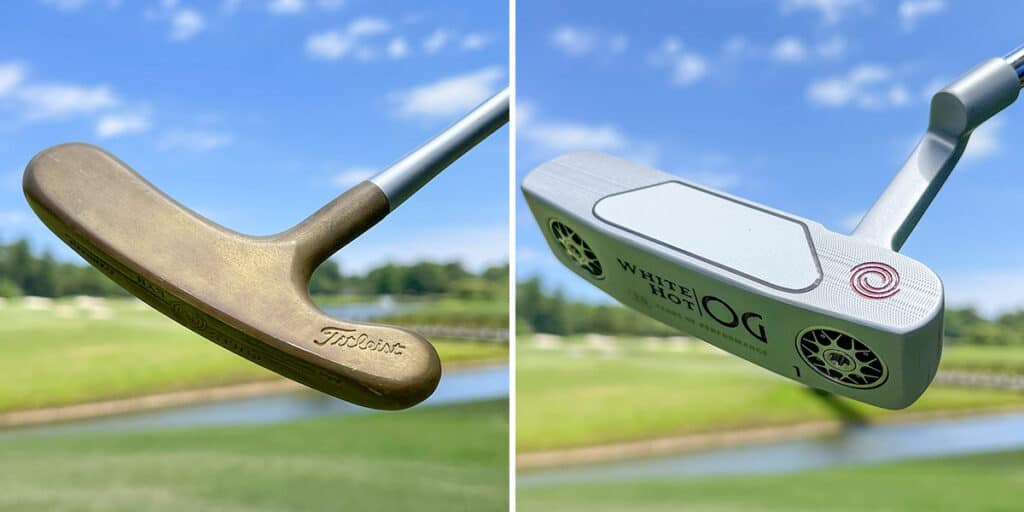
Blades don’t offer as much in terms of alignment aids, ensuring the putter head is flat to the putting surface, and often don’t find themselves in the “forgiving putter” category like their new mallet counterparts.
On the other hand, as putter manufacturing technology and engineers have had more time to experiment, increased heel and toe weighting to blade designs have increased consistency and forgiveness for blades but are still far less game improvement based than a mallet.
Where a blade really excels is its simplistic nature. A blade’s minimal look at address can calm a busy mind when standing on the green.
Most of the best putters throughout history have used a blade or even the same blade throughout their careers because they are so used to the feeling that the blade provides their game and putting stroke.
Blade putters often feature considerable toe weighting, which many manufacturers claim allows for a more arc type putting stroke to close while making a putting motion naturally.
I believe too many people get focused on the “straight back” vs. “arc stroke” putting stroke debate. Still, as someone with a slight opening in the takeaway and closing in the follow through of my putting stroke, I have found a benefit to using a blade putter for the last 12 years of my golfing life.
Additionally, as someone with a busy mind on the golf course, when things aren’t feeling as “easy,” mallet putters tend to become an added distraction to someone like me with their amped-up designs, color schemes, and overall bulkier appearances.
Who Uses Blade Putters?
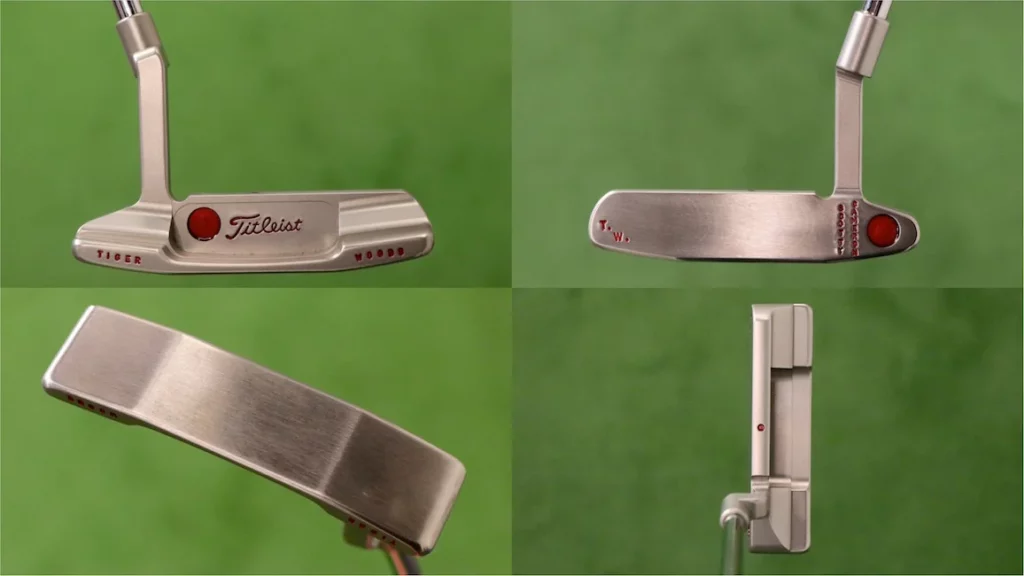
Above is an image of Tiger Woods’ backup putter that sold for 393,000$ in 2021.
Tiger is well respected as one of, if not the greatest, clutch putters in all of golf. He has used a blade putter for the entirety of his career, besides very brief experimentation periods in 2010-11 and a 5 event stretch in 2018 where he committed to a mallet.
Simply put, golfers who are confident in their ability to put a good stroke on the golf ball and start it at their intended target line tend to fall toward the blade style putter options. Everybody’s heard players talk about being “feel” or “analytics based” players, and blades align more with the “feel” side of golfers.
That is not meant as a damning statement toward mallet putters and their owners. Blade putters are just a common theme amongst the best putters and the best “feel players” in history.
Blade putters often lack the larger or multiple alignment aid options of many mid to full sized mallet putters.
Players who have made the switch from a mallet to blade often initially comment that they have to think more critically about how they are aligning the ball because they are required to do more work to ensure the putter face is square to their intended target at address.
While not an automatic characteristic on all blade putters, many blades feature interchangeable weights at the rear of their club heads so that users can customize the weight and feel of their blades even further. (leaning into the idea that blades are for more “feel based players”)
Blades can often feel lightweight, particularly when compared to their mallet counterparts. If you’re usually putting on fast greens, you might find benefit from the lighter putter design and more speed control blades can offer.
What is a Mallet Putter?
Mallet putters essentially offer more in every category of the putter, when compared to the simplistic blade.
Mallet putters offer more in terms of head shapes and sizes, as we discussed earlier. Players can find half moon, half circle, square, triangle, flying-v, “X” shaped, honestly, an endless amount of head shapes when looking for a mallet instead of a blade putter.
In addition, mallet putters offer more perimeter weighting and overall weight to the golfer’s hands, resulting in less face twisting on the stroke and greater forgiveness to players unable to hit the sweet spot of their putter face repeatedly.
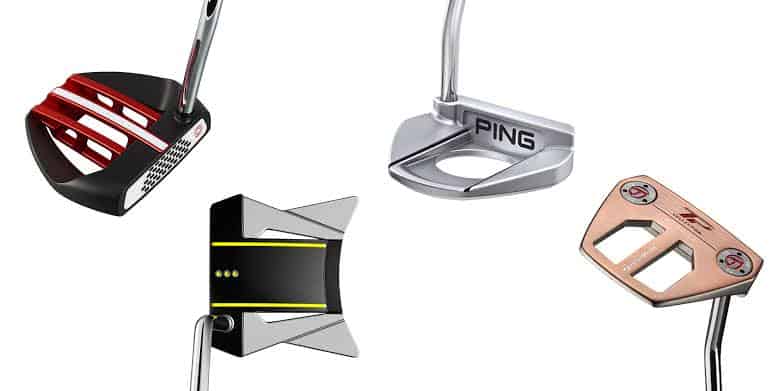
Due to the increased M.O.I. from the larger club heads and greater perimeter weighting, putts hit off the center of a mallet putter face will be closer to the intended distance of the putt, whereas blade putters require more precise distance control by the player.
If you want a bit of help with alignment and balance, want a heavier feeling during your putting stroke, and would prefer a straight back and straight through style putting stroke as compared to releasing the putter face a bit more like with a blade, a mallet putter will benefit your game tremendously.
I’d be remiss not to mention many of the best putters of the current pro golf world use and see benefits from having a mallet putter in their bag. You don’t have to be a poor putter to use a mallet, but you do have to have a harmonious putting style and stroke with a mallet to use one effectively.
Difference Between a Mid Mallet Putter and a Full Mallet Putter
Mid mallet putters are a cross between the traditional blade style putter and a full sized mallet.
Mid mallets generally have more toe hang than their often face balanced full sized mallet big brother and could comply with many different styles of putting stroke.
Full mallets are as packed with as much game improvement technology as a putter can hold. They are designed to be balanced, stable, and forgiving to putts that miss the center of the putter face.
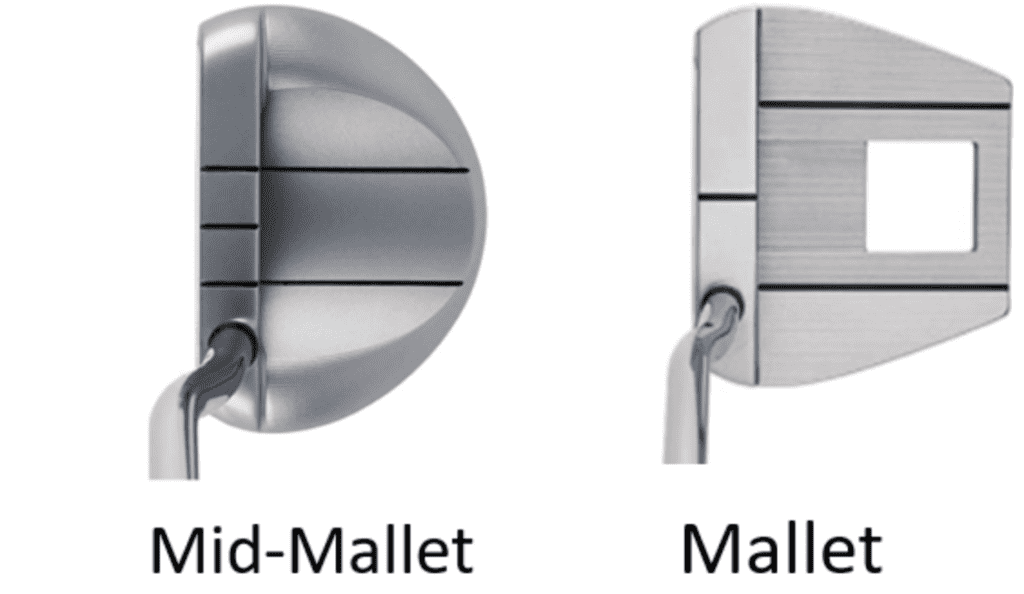
Full mallets have the most significant club head size of any putter design, offer the longest or most regarding alignment lines or aids, and give the most “weighty” feel to players’ hands. Players who don’t want to feel the putter face release as the putting stroke is made should look for a mid or full sized mallet putter.
P.G.A. Tour Players Who Use Blade Putters:
While 5 to 10 years ago, it would’ve been the resounding majority of PGA Tour level pros that use a blade putter, recent technological advancements have made blades the slight minority for the first time out of putter types used in the Top 50 Official World Golf Ranking (OWGR) players.
Notable PGA Tour (and now LIV Golf) players that use a blade putter are:
Tiger Woods
Cameron Smith
Collin Morikawa
Matt Fitzpatrick
Jordan Spieth
Tony Finau
Tom Kim
Hideki Matsuyama
Joaquin Niemann
Tommy Fleetwood
P.G.A. Tour Players Who Use Mallet Putters:
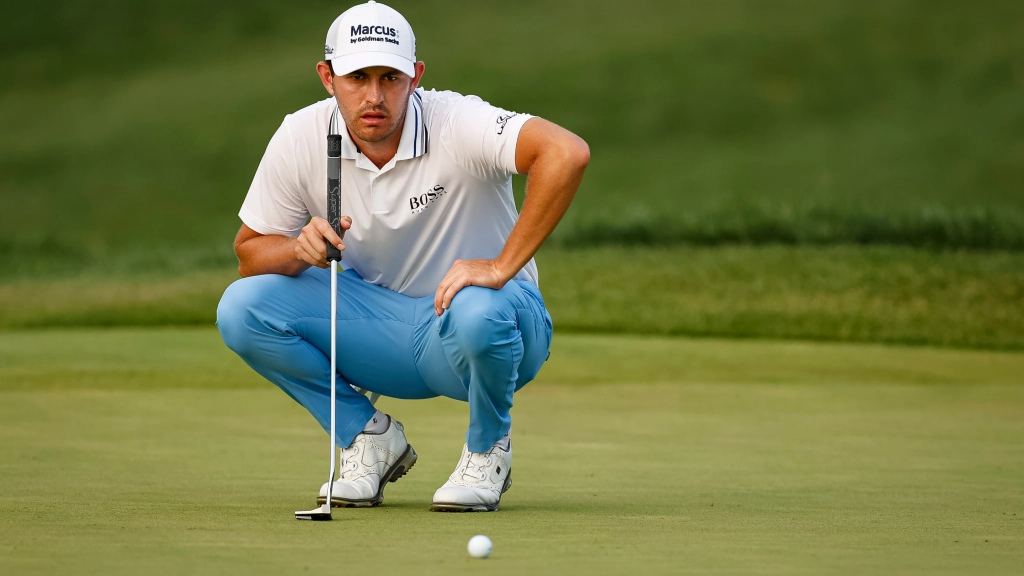
As of 2018, 44 percent of the Top 50 OWGR players were using mallet putters. As of 2022, 62% of the Top 50 players in the OWGR use mallet putters, and a resounding 70 percent of the Top 50 in the Stroke Gained Putting statistic were using mallet putters.
Notable players on the PGA Tour who use a mallet putter:
Rory McIlroy (current World No. 1)
Scottie Scheffler
Patrick Cantlay
Jon Rahm
Xander Schauffele
Will Zalatoris
Justin Thomas
Viktor Hovland
Cameron Young
Billy Horschel
Other Factors to Consider When Finding Your "Perfect Putter"
Ping and Odyssey Golf have two schools of thought on the matter. Ping suggests that if a golfer has an arc in their stroke, they will benefit from a toe hang putter. A face-balanced putter will be beneficial if a golfer putts more straight back and straight through.
Odyssey believes if a golfer misses more putts to the right, a toe-hang putter will help the golfer, and if they miss more putts to the left, a face-balanced putter would be better. Both face-balanced and toe-hang putters come in blades and mallets.
Final Thoughts With @ScramblingTom
Tiger is considered one of the best “feel” players in golf history. Videos of him closing his eyes and visualizing shot shapes, talking about “putting into the picture,” and stories of him playing in the dark as a child only fan the flames on the legend that he has a superior “feel” to other pros in his class.
To the right is a photo of his classic Scotty Cameron Newport 2, with which he has won most of his Major and regular P.G.A. Tour Tournament victories (14 of his 15 majors, 65 of his 81 P.G.A. Tour titles, and $92 million with his Scotty Cameron in his bag).
One thing you may notice, besides the missing paint and dings and scratches accumulated over the years, is the slight residue left under the Titleist lettering on the back of the face.
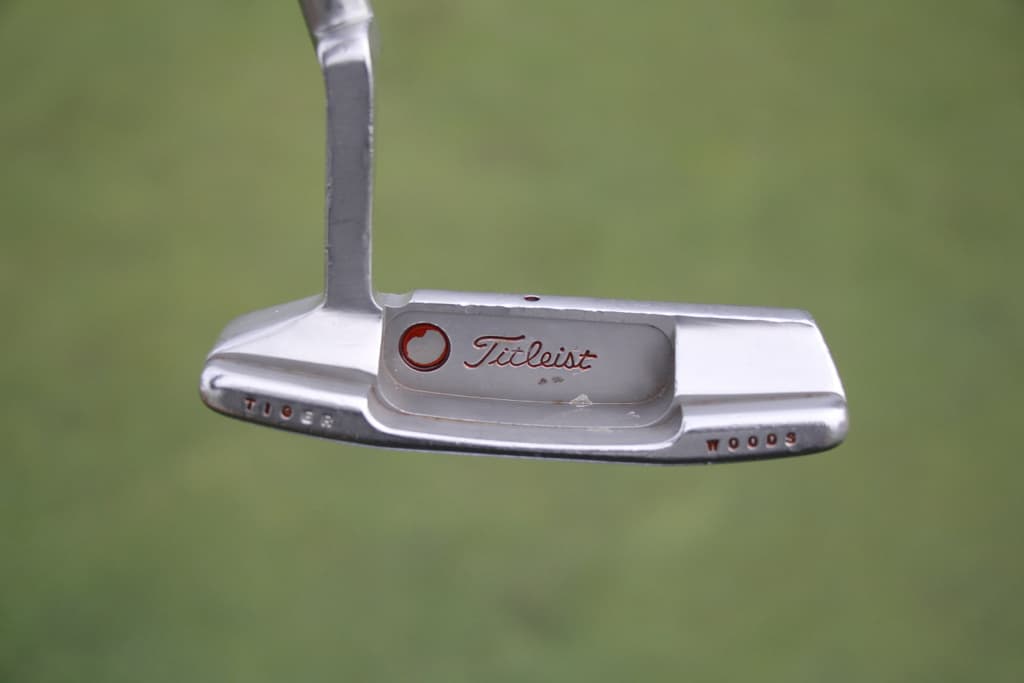
This residue results from many instances of adding and removing lead tape to this tiny cavity behind the putter face. When Tiger knows there will be slower greens at an upcoming tournament venue, he will add lead tape to the head of the putter to improve his feel, distance control, and lower his chance of accidentally increasing his swing speed on the green.
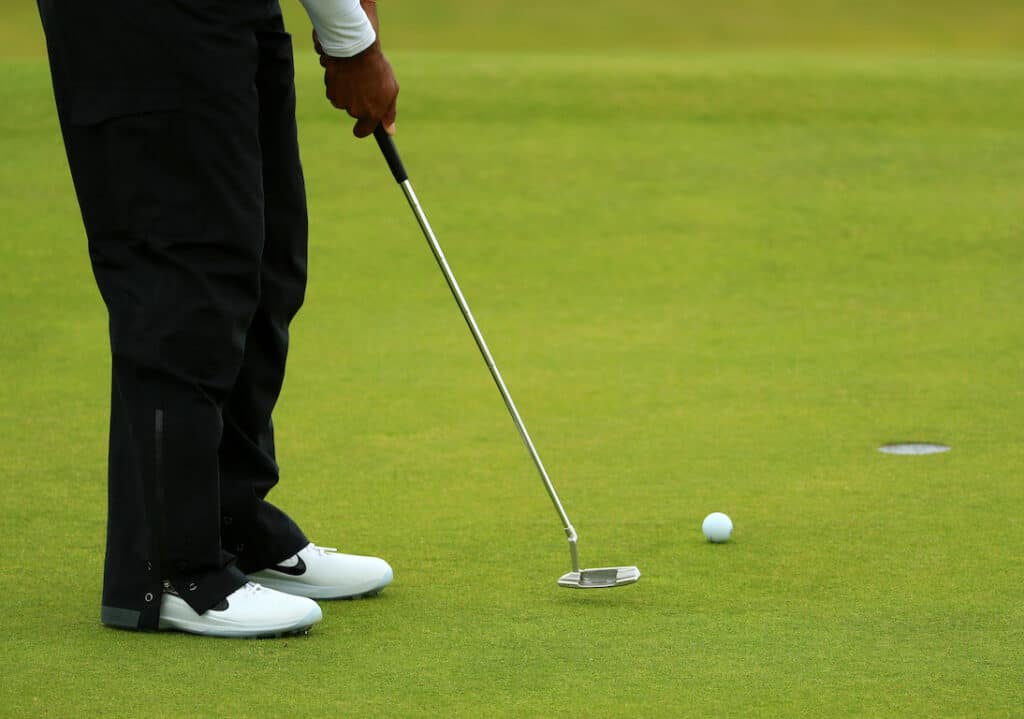
He trusts his ability to hit the sweet spot and make the putting stroke he feels most confident with using his faithful Scotty Cameron and would rather add heavy tape than use something else.
Tiger has deviated from his classic blade head shape a few times but never for long, always inevitably returning to his beloved Newport 2. Someone with as much access to new golf equipment technology as Tiger has surely tried every type of blade or mallet putter out there but still finds he has the most confidence looking down at his favorite putter.
The overarching lesson from what many believe is the most clutch athlete of all time and putters is to never be afraid to experiment when things are rough, and try to find a putter that makes you feel comfortable and confident when standing over the ball.
“Obviously there have been times it hasn’t been cooperative, so I’ve had to bench it,” Tiger told GolfWeek in 2019. “I’ve struggled with it every now and then. But you know, it’s one of those things where I bring it back out, go in the backyard, putt with it and then I go, ‘Ooh, there we go.’ I just keep going back to it.”
About The Author
Writers of Independent Golf Reviews
Independent Golf Reviews has tested and reviewed 1000+ golf products over the past 10 years. We use our experience and expertise to give golfers an unbiased insight on the market.
Read more…
Share
Receive the best golf discounts available exclusively for our subscribers and be auto entered into our monthly golf giveaways!
Success!⛳️
You are now an official member of IGR. Keep an eye out for the perks.
No spam, ever. 🔒

